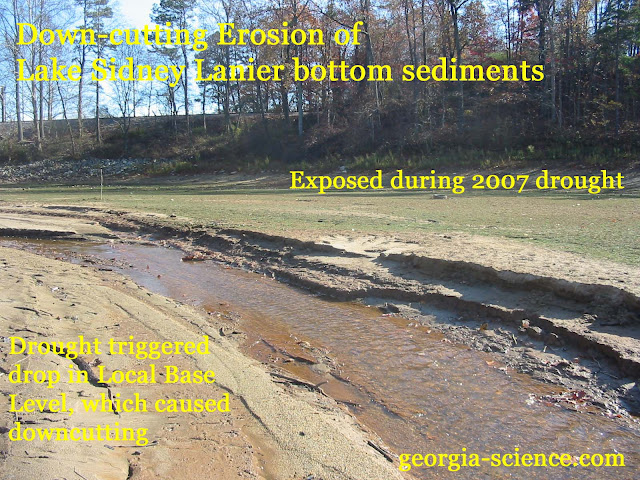Understanding the concept of Base Level is an important part of understanding the behavior of streams, erosion, and subaerial (terrestrial) stream deposition.
"Base Level" (mentioned briefly here) as a concept was defined by John Wesley Powell and is the lowest point to which a stream can erode at any one point. More info is presented here.

Figure 2.
Ultimate Base Level is Mean Sea Level, i.e., rivers and streams cannot erode any deeper than sea level.
Over geologic time, Ultimate Base Level changes with changes in sea level. The primary causes of Mean Sea Level are variations in polar icecap coverage (more ice = lower sea level) and variations in plate-tectonics oceanic rift zone activity.
When rift zones are more active, the seafloor is bulged upwards by the rising mantle plumes, which displaces seawater and raises sea level. When rift zone activity slows, sea level drops. Add to this local changes in the elevation of continental margins. When the edge of a continent rises, that mimics a sea-level drop (aka a Regression) and vice versa when the edge of a continent sinks, that mimics a sea-level rise (aka a Transgression).
When the Ultimate Base Level rises, the "Ultimate Stream Gradient" (from the ultimate stream/river source) is decreased, resulting in more deposition. There will be deposition also in any "drowned" portions of previously exposed river systems. When Ultimate Base Level drops, the Ultimate Stream Gradient increases (steepens), resulting in more erosion.
Within every river and creek system, there are innumerable "Local Base Levels", points below which the upstream river (or creek) cannot erode. Local Base Level controls the upstream gradient on that particular river/creek until the next higher-elevation Local Base Level.
In the second photo, there is a small example of a Local Base Level, established by this small outcrop in Chickamauga Battlefield Park, Georgia. Upstream from this locally resistant outcrop, the stream is prevented from down-cutting any further. The next ledge or another outcrop upstream then establishes the next upstream Local Base Level.
As changes in sea level affect the Ultimate Base Level and the Ultimate Gradient, changes in a Local Base Level affects Local Stream Gradients. When a dam is constructed (or when a landslide naturally forms a pond/lake), that raises the Local Base Level, resulting in more deposition.
When Lake Lanier was constructed a little more than 50 years ago, the rising "pool elevation" raised the Local Base Level of all streams entering the lake. In the upper photo, you see the exposed lake-bottom sediments, contributed by local hillside erosion and by deposition of sediments contributed by this particular small stream, over the course of 50 years.
When the extended drought and dam releases caused a lowering of the pool elevation, that lowered the Local Base Level and resulted in the few inches of erosion (down-cutting) that you see in the upper photo. When the lake returns to its Full-Pool elevation, the upstream Local Base Levels will again rise and down-cutting will cease and sedimentation will resume.
There are characteristic stream behaviors that are affected by the steepness of the stream gradient (Ultimate and Local). When you have a steep gradient (low Ultimate Base Level or Local Base Level), you have more down-cutting in the stream valleys. When the Base Level suddenly rises, the upstream valleys are "back-filled". Remember, subsidence of a continental margin can mimic a Base Level rise.
On Coastal Plains and River Deltas, where the gradient is very low, lateral erosion causes migration of the stream channels and the resulting meanders. And usually, in this situation, you have wide floodplains and/or local low-relief topography.
When you have a low-gradient feature, such as river meanders, in an area with great topographic relief, that can tell you of a rapid drop in Ultimate Base Level or a rapid uplift of the landmass, such as with the Colorado Plateau (discussed in the next post of this series) or with some other regional feature, such as the land surrounding the Black Canyon of the Gunnison River, in Colorado.
Changes in Local Base levels (including some caused by human activities) can have smaller-scale effects on local streams (as described above regarding Lake Lanier).

No comments:
Post a Comment